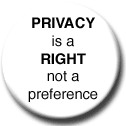The Whistleblower Who Exposed Warrantless Wiretaps
Michael Isikoff writes on Newsweek.com:
Thomas M. Tamm was entrusted with some of the government's most important secrets. He had a Sensitive Compartmented Information security clearance, a level above Top Secret. Government agents had probed Tamm's background, his friends and associates, and determined him trustworthy.More here.
It's easy to see why: he comes from a family of high-ranking FBI officials. During his childhood, he played under the desk of J. Edgar Hoover, and as an adult, he enjoyed a long and successful career as a prosecutor. Now gray-haired, 56 and fighting a paunch, Tamm prides himself on his personal rectitude. He has what his 23-year-old son, Terry, calls a "passion for justice." For that reason, there was one secret he says he felt duty-bound to reveal.
In the spring of 2004, Tamm had just finished a yearlong stint at a Justice Department unit handling wiretaps of suspected terrorists and spies—a unit so sensitive that employees are required to put their hands through a biometric scanner to check their fingerprints upon entering. While there, Tamm stumbled upon the existence of a highly classified National Security Agency program that seemed to be eavesdropping on U.S. citizens. The unit had special rules that appeared to be hiding the NSA activities from a panel of federal judges who are required to approve such surveillance. When Tamm started asking questions, his supervisors told him to drop the subject. He says one volunteered that "the program" (as it was commonly called within the office) was "probably illegal."
Tamm agonized over what to do. He tried to raise the issue with a former colleague working for the Senate Judiciary Committee. But the friend, wary of discussing what sounded like government secrets, shut down their conversation. For weeks, Tamm couldn't sleep. The idea of lawlessness at the Justice Department angered him. Finally, one day during his lunch hour, Tamm ducked into a subway station near the U.S. District Courthouse on Pennsylvania Avenue. He headed for a pair of adjoining pay phones partially concealed by large, illuminated Metro maps. Tamm had been eyeing the phone booths on his way to work in the morning. Now, as he slipped through the parade of midday subway riders, his heart was pounding, his body trembling. Tamm felt like a spy. After looking around to make sure nobody was watching, he picked up a phone and called The New York Times.








0 Comments:
Post a Comment
<< Home